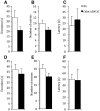Behavioural abnormalities in a novel mouse model for Silver Russell Syndrome
- PMID: 27798108
- PMCID: PMC5418837
- DOI: 10.1093/hmg/ddw357
Behavioural abnormalities in a novel mouse model for Silver Russell Syndrome
Abstract
Silver Russell Syndrome (SRS) syndrome is an imprinting disorder involving low birth weight with complex genetics and diagnostics. Some rare SRS patients carry maternally inherited microduplications spanning the imprinted genes CDKN1C, PHLDA2, SLC22A18 and KCNQ1, suggesting that overexpression of one of more of these genes contributes to the SRS phenotype. While this molecular alteration is very rare, feeding difficulties are a very common feature of this condition. Given that SRS children also have very low body mass index, understanding the underpinning biology of the eating disorder is important, as well as potential co-occurring behavioural alterations. Here, we report that a mouse model of this microduplication exhibits a number of behavioural deficits. The mice had a blunted perception of the palatability of a given foodstuff. This perception may underpin the fussiness with food. We additionally report hypoactivity, unrelated to anxiety or motoric function, and a deficit in the appropriate integration of incoming sensory information. Importantly, using a second genetic model, we were able to attribute all altered behaviours to elevated expression of a single gene, Cdkn1c. This is the first report linking elevated Cdkn1c to altered behaviour in mice. Importantly, the findings from our study may have relevance for SRS and highlight a potentially underreported aspect of this disorder.
© The Author 2016. Published by Oxford University Press.
Figures





References
-
- Wakeling E.L. (2011) Silver-Russell syndrome. Arch. Dis. Child., 96, 1156–1161. - PubMed
-
- Eggermann T., Begemann M., Spengler S., Schroder C., Kordass U., Binder G. (2011) Genetic and epigenetic findings in Silver-Russell syndrome. Pediatr. Endocrinol. Rev., 8, 86–93. - PubMed
-
- Eggermann K., Bliek J., Brioude F., Algar E., Buiting K., Russo S., Tumer Z., Monk D., Moore G., Antoniadi T., et al. (2016) EMQN best practice guidelines for the molecular genetic testing and reporting of chromosome 11p15 imprinting disorders: Silver-Russell and Beckwith-Wiedemann syndrome. Eur. J. Hum. Genet., 24:1377–1387. - PMC - PubMed
Publication types
MeSH terms
Substances
Grants and funding
LinkOut - more resources
Full Text Sources
Other Literature Sources
Molecular Biology Databases

